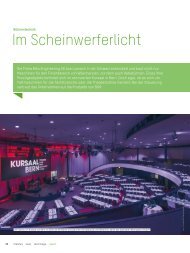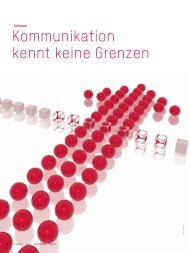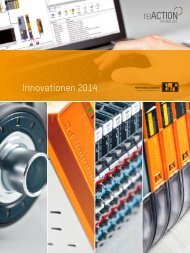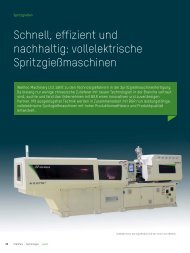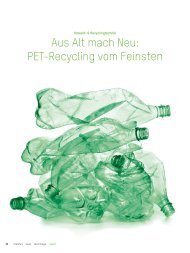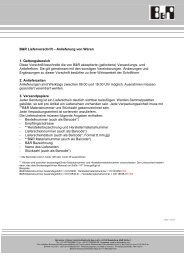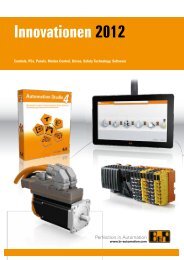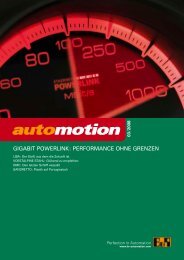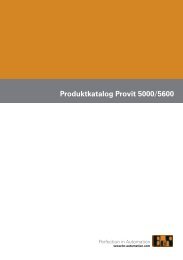automotion automotion automotion automotion - B&R Industrie ...
automotion automotion automotion automotion - B&R Industrie ...
automotion automotion automotion automotion - B&R Industrie ...
Create successful ePaper yourself
Turn your PDF publications into a flip-book with our unique Google optimized e-Paper software.
programmed so that the applicator<br />
unit automatically goes to the second<br />
dispenser as soon as the first<br />
dispenser is empty or the carbon<br />
tape is used up. Since the empty<br />
dispenser can be refilled while the<br />
second dispenser is working, the<br />
machine is now ready for continuous<br />
operation. michael Brandt and<br />
his team of experts at CFS have been<br />
able to accomplish this thanks to a<br />
sophisticated modular system and<br />
revolutionary drive and control technology<br />
from B&R.<br />
Flexible configuration<br />
Since the downtimes caused by<br />
changing label reels do not present<br />
the same problems in every processing<br />
line, CFS offers the tiroLabelNt<br />
in various models - the entry level<br />
tiroLabelNt 201 with one dispenser<br />
and one applicator unit, tiroLabelNt<br />
202 with two dispensers and one<br />
applicator unit for systems with a<br />
throughput of 120 to 170 packages<br />
per minute, and the high-end model<br />
TiroLabelNT 203 with two dispensers<br />
and two applicator units for the<br />
most demanding applications.<br />
"A labeler with two dispensers<br />
has more uses than simply reducing<br />
downtime," emphasizes Brandt.<br />
"the user could also apply a second<br />
promotional label, such as '2 for the<br />
price of 1' or 'Now with 20% more',<br />
without the added time and effort<br />
this usually requires." And if two<br />
dispensers and one applicator unit<br />
are not enough, there's always the<br />
labeler with two applicator units.<br />
High-tech from B&R makes it<br />
possible<br />
the new tiroLabelNt machine concept<br />
was only possible using newly<br />
developed technology: Since the dispenser<br />
and applicator are no longer<br />
one unit, and the dispenser is placed<br />
in an optimum position for the selected<br />
packaging format and remains<br />
there during operation, the applicator<br />
unit must return to the dispenser<br />
after each cycle. "Just to achieve the<br />
same productivity as conventional<br />
systems, the applicator unit must<br />
move more quickly than with previous<br />
approaches," explains<br />
Brandt. "that's why our<br />
labeler uses a linear motor<br />
that can accelerate at 2 g<br />
to provide the necessary<br />
dynamic drive for the applicator<br />
unit. In addition to<br />
the increased throughput,<br />
this technology is also absolutely<br />
maintenance-free<br />
because it doesn't require<br />
parts such as toothed<br />
belts that are subject to<br />
wear and tear." the motor<br />
is controlled by an intelligent<br />
servo drive from<br />
B&R's ACOpOS line. "B&R<br />
It is also possible to apply<br />
two different labels in one<br />
process.<br />
Application<br />
In the full version of the labeling machine, 16 intelligent<br />
servo drives from the ACOPOS series are used to control<br />
the motors.<br />
agreed right away to handle integration<br />
of the linear motor and create<br />
all of the drive-related software. this<br />
was a great experience for us that<br />
confirmed our decision to trust B&R<br />
with not only the control and visualization<br />
- like with all of our machines<br />
- but also with the drive technology,"<br />
reports Brandt. For the tiroLabelNt<br />
the latter was quite extensive: The<br />
labeling system utilizes a total of 16<br />
servo drives.<br />
Winder drive replaces mechanical<br />
coupling<br />
The dispenser unit alone requires<br />
two servo motors (or ACOpOS<br />
drives): Like the applicator unit, the<br />
dispenser unit must also work faster<br />
to avoid any unnecessary delays.<br />
Here the servo replaces the stepper<br />
motor that is usually used to<br />
wind the label reels. the mechanical<br />
coupling previously used to drive<br />
the reel, around which the backing<br />
material is wrapped after the labels<br />
are removed, has also been replaced<br />
with a servo motor. "this drive is<br />
torque-controlled, which prevents<br />
unwanted loop formation and band<br />
vibrations, even at higher speeds<br />
and with the use of modern backing<br />
materials. Overall the material is<br />
simply handled more gently," adds<br />
Brandt.<br />
the B&R drives provide optimum<br />
support for the decentralized architecture<br />
selected by CFS: each<br />
modular dispenser unit has its own<br />
switching cabinet which contains the<br />
drives and the I/O modules, also from<br />
B&R. "Both the ACOpOS drives >><br />
<strong>automotion</strong> 07/2009<br />
57



